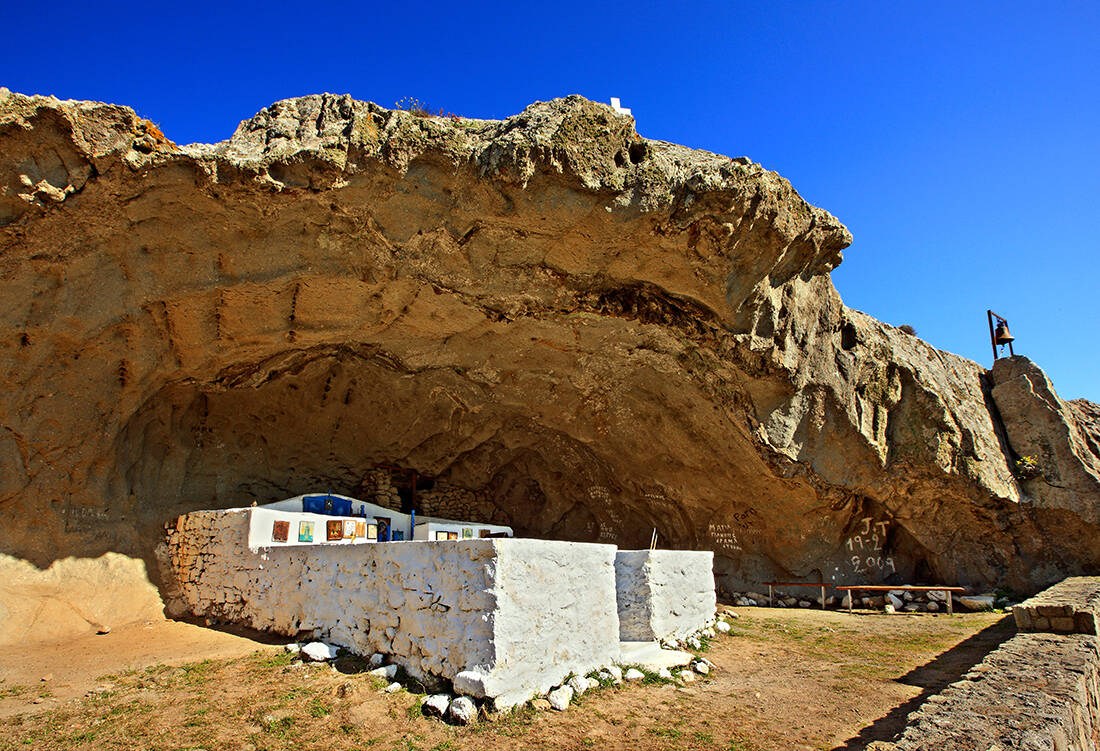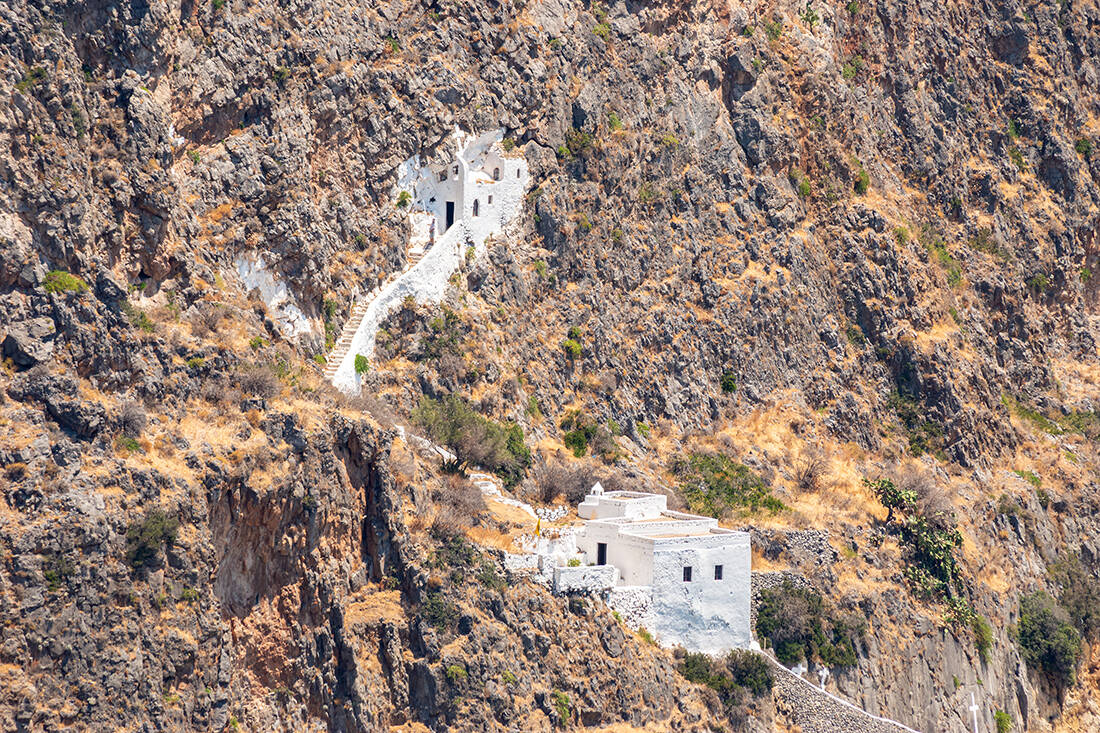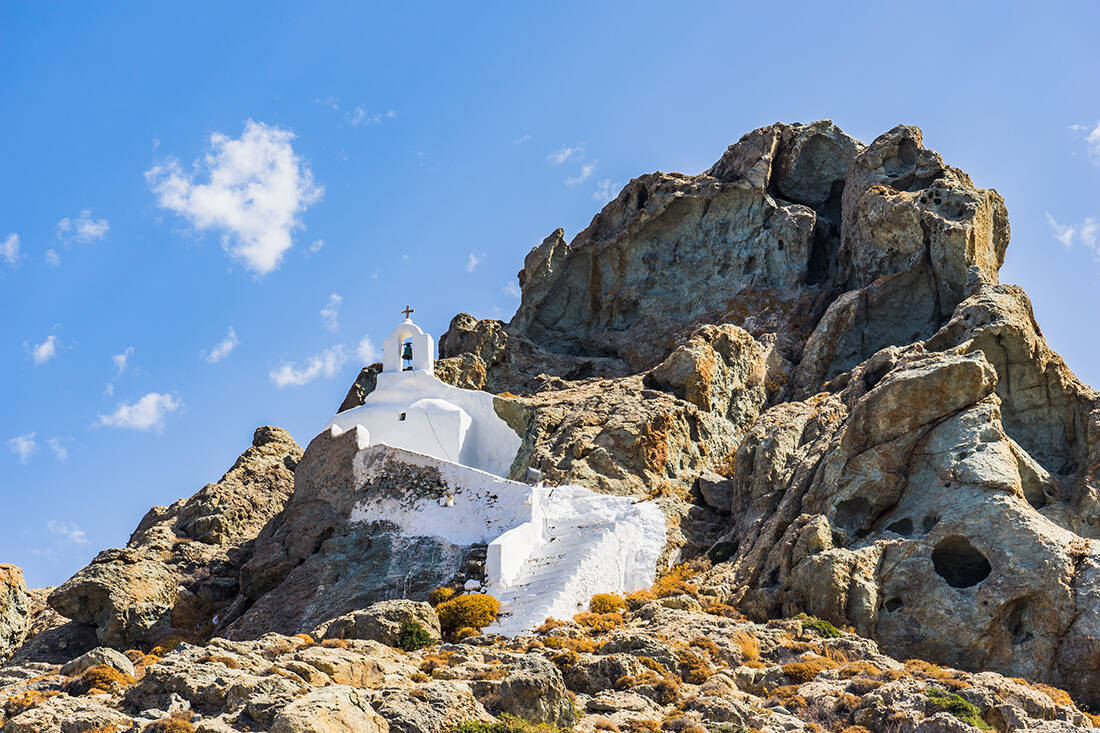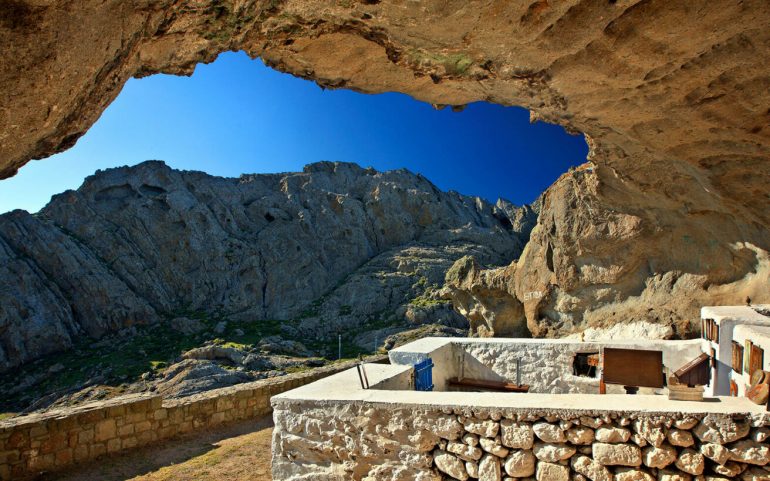Simple, unpretentious and at the same time imposing, the chapels of rocks cause awe and admiration. The drama of the landscape with the high rocks on which they are carved and the stone caves that embrace them lazily, create shocking images that remain forever in the memory.
Narrow stairs, stone or built, carved on the rock, lead to tiny churches that stand out for the all-night atmosphere, the peace and quiet that they offer to those who manage to approach them.
From Skyros to Kythira and from Corfu to Lemnos, discover the most impressive chapels perched like white eagle nests on steep cliffs and let your gaze be enchanted by what you see, making you wonder if it really is real.

An Aegean church of impressive picturesqueness is found on Pouria beach, after the area of Gyrismata, in Skyros. As a white touch, the church of Agios Nikolaos is carved on an impressive porous rock that "gazes" at the sea from above. The cave white church is located at the site, where in antiquity there was a quarry of poros, and dates back to before 1806.
To enter the tiny temple, go down two or three steps and find yourself in another world. The interior of Agios Nikolaos is as small as one can imagine, with simple and narrow spaces, few images and little candles lit by passers-by visiting the area of Pouria. On the rock around the church there are many, in fact, who test their performance in climbing.
The image that one sees as soon as one is here with the rock, the small church, the ancient quarry and the windmill reminds 100% of summer Greece with the view of the endless blue of the sea to take your breath away.

Although it is a tiny chapel, Panagia Kakaviotissa holds a world record. It is the only small church in the world without a roof. This unique attraction is located on its island Lemnos, near the village of Zemata, just 4 km from the port of Myrina, and owes its name to the mountain Kakavo where it is built under a cave.
Its admirable architecture makes it one of the most famous sights of the island, as countless visitors come here every year to admire up close this unique, global "phenomenon".
Its creation dates back to approximately 1300 when hermit monks chose this place to practice asceticism, while since 1305 it has been the property of the monastery of the Great Lavra.
The ascetics built this small temple under the rocky balcony, in order to perform the divine service, while over the years the monks passed away and the last remaining left Lemnos to asceticize on Mount Athos. There is only one service a year, every Tuesday after Easter.
To reach the chapel you take the path that leads to the top of Mount Kakavos, a route of about 1300 meters, lasting 15 minutes. The wonderful landscape all around and the dreamy view of the bay of Moudros in what definitely impresses the visitor, beyond the peculiarity of the temple.

On an imposing vertical rock above Kapsali, the port of Chora of Kythera, is perched the church of Agios Ioannis "in Krimno" or "in Gremnon". At an altitude of about 100 meters above sea level, and after climbing 130 steps in a beautiful pine forest, the visitor is in front of a cave, in which is a small naidrio dedicated to St. John the Baptist.
According to the inscription at the entrance, the church was renovated in 1725 by the monk Ioannikios, while it is celebrated every year on the day of Agios Ioannis the Forerunner. Tradition has it that at this point St. John the Theologian, persecuted by Rome, began writing the Apocalypse before going to Patmos.
Η view from the main staircase of Naidrio, weather permitting, reaches Crete, while the nearest Antikythera are more easily visible. Of course, the view magnetizes the impressive Castle of Kythera and the rocky islet of Chytra, just opposite.

Just outside Naxos Town, like an eagle's nest hanging from the steep cliffs, there is a small and picturesque church. The pale white touch on the gray of the granite rocks, located north of the monastery of Agios Ioannis Chrysostom of the 17th century, is dedicated to Agios Ioannis the Theologian, for the locals it is also known as Theologaki, while it has connected its name with that of Nikos Kazantzakis.
According to testimonies, both this church and its dreamy and remote location were one of the favorite places of the greatest Greek writer of modern times, when he lived on the island and attended the French School of Naxos.
One of the main characteristics of the fact that most of the small church consists of the rocks of the cave, while only a wall was built for the facade and the bell tower. Impressions on its walls are traces of inscriptions and murals dating back to before 1200.
Below the traditional village of Afionas, in the northern part of the island is one of the most remote and inaccessible beaches of Corfu. To reach Porto Timoni you take one of the two paths that start from the village and reach a dream destination with two beaches.
On the way to the end of the peninsula leading to beach is the small church of Agios Stylianos, carved into a cave. A tiny "refuge" for the image of the Saint who gave him his name, protected from both the weather and the prying eyes.
According to history, the point for its creation was indicated by Agios Stylianos himself. Legend has it that a shepherd looking for one of his lost sheep discovered the image of the saint among branches. However, the next day and after he had placed it in the church of the village so that all its inhabitants could worship it, the image disappeared, everyone believing that someone had stolen it. Something that did not really happen.
The shepherd found her once again in the same place and the villagers agreed to keep her at the place where she was discovered for the first time by the shepherd, that is, in the cave where she is still today.
